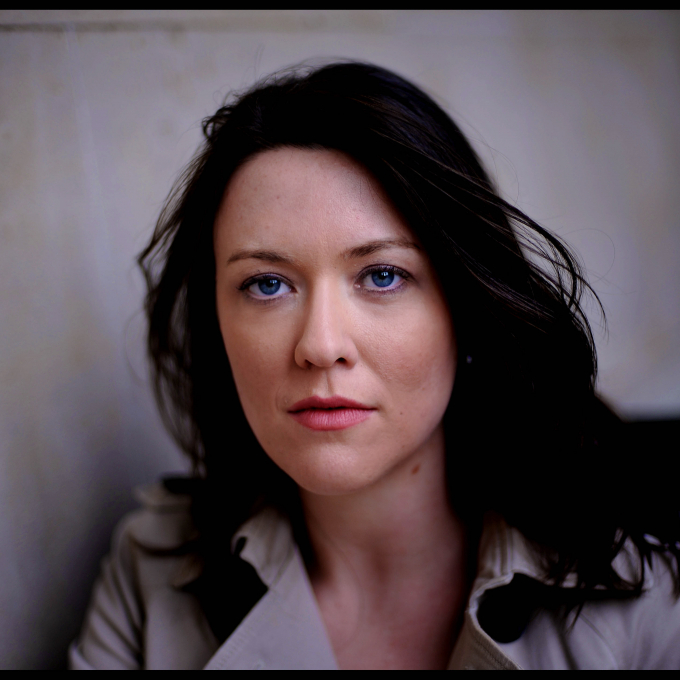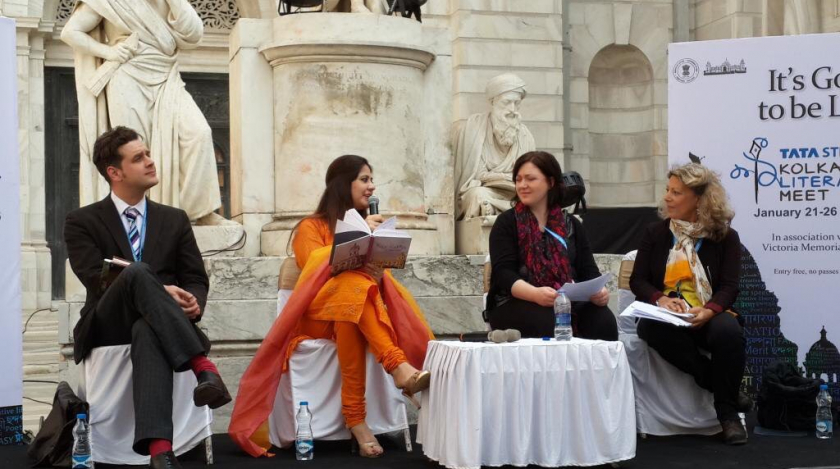
- ©
- Sarah Lee
Biography
The poet Emma Jones was born in Sydney and studied at the universities of Sydney and Cambridge. Her first book, The Striped World (2009), has won the Forward Prize for Best First Collection, the Queensland Premier's Literary Award for Best Collection and is shortlisted for the John Llewellyn Rhys Prize. She is one of the Poetry Book Society's Next Generation Poets for 2014.
She has written the libretto for City Songs, a contemporary oratorio, with composer Eriks Esenvalds, which premiered at The Round House in London with vocalist Imogen Heap. Emma has held writing fellowships in Cambridge, the Lake District, Rome and Riga, and is at work on a second book. She tutors in poetry on Oxford’s MSt in Creative Writing.
Critical perspective
The Sydney-born, England-based poet Emma Jones is the author of The Striped World (2009), one of the more celebrated début collections of recent years.
Hailed by the Weekend Australian as “one of the most exciting new voices in poetry.” Jones has been making waves with work in which caged animals and historical echoes are brought to life with trademark philosophical wit.
For an emerging poet to have their work published by Faber is an impressive feat. But more than that, it is an excellent fit for Jones. That publishing house seems particularly apt for a poet who has regularly expressed her affection for many of the great Faber names she sees as poetic role models, including Marianne Moore, Sylvia Plath, T.S. Eliot and John Berryman. The Striped World saw Jones confidently announcing her arrival within this tradition.
Jones first came to prominence as the winner of Australia's prestigious Newcastle Poetry Prize in 2005 for her elaborate dialogue poem ‘Zoos for the Dead'. This piece took the form of an exchange between narrator and a parrot, named Narcissus, “the survivor of an atrocity”, the last speaker of a lost language, its owners having taken the tribal language to their graves. Jones prefaces the poem with a historical note on the Australian government’s historic policy of the removal of children from Aboriginal families, and the poem becomes a striking route into these difficult historical memories. The result is a challenging surrealist collage, mixing loose, long-lined tercets with shorter fragments of dialogue, speech and song. The piece was celebrated as a strikingly original revisiting of Australia’s dark past.
By the time of that poem’s publication Jones was already based in England at Cambridge University, becoming active in the poetry scene there. It was here that she was spotted and directed towards Faber for her debut collection. The English poet Jacob Polley recalls his response in hearing Jones read her own work in 2006. "I just thought 'wow'. Where did she get this stuff from?," he remembers, "I thought I would bring a few people together to read out some of their poems … It wasn't supposed to be a talent spotting session, but suddenly it got really exciting. [Jones’s] poem was confident, and moving and funny and it was about stuff, about serious ideas."
These serious poems and promising pieces came together in The Striped World, published in 2009. It was a collection fixated above all on with the complex symbolism of animals and their habitats: menagerie, zoo, cage, city and shore, and the ideas of violence, power and order they suggest. The collection was also marked by a keen artistic self-awareness and positive sense of literary heritage, strains of the Faber poets mentioned above (particularly Eliot and Plath) but also of the humour of Elizabeth Bishop and Wallace Stevens, and the very different wit of Larkin, and of Auden and Adrienne Rich.
One of the key motifs of the work is the trope of captivity, and Emma Jones explains how this provides a key to the collection’s title:
There’s also a lineage of caged animals in poetry... the title of the collection came to me quite late, though looking back it unites so many of the poems. I’d been trawling through and reread my poem “Sentimental Public Man” – which isn’t openly about zoos at all, and came across the lines ‘my barred heart / saw the striped world move like a beast’, which I realized was a concentration of what many of the poems were on about – the way subjectivity is a little enclosure, and the world the thing that is looked at, and that looks at you. (thedrunkenboat.com)
“Zoos are a tiny empire,” she has pointed out, “And conceptually they cluster together all sorts of things – notions of collection, arrangement, taxonomy, perception, spectatorship, ownership, how I tell what I am, what you are.” And the complex sense of enclosure that such spaces suggest recurs as a key theme throughout the collection.
Faber have promoted the collection in terms of what the jacket calls Jones’s “tidal imagination,” and certainly there is a global sense of place in the book. Jones is ambivalent about being seen as an Australian poet, stating in interviews that:
I’m an Australian who lives in Europe a lot of the time. My mother was English. I’ve moved around a lot in the last five years. I don’t often feel very at home, or very foreign. …. are [my poems] always interpreted through a lens of strangeness, because of where I grew up? Probably. But I don’t think I’m interested in change and difference because I travel; I think I travel because I’m interested in difference and change.
And yet the theme of Australian history re-appears constantly in The Striped World. The poems are deeply weighted by the nation’s troubled history, and its key themes of opportunity, belatedness, settler guilt and frustrated relationship to Eurocentric poetic culture. Moreover, as Frances Leviston wrote in the Guardian, Jones’s “post-colonial unease, the question of what's left in and what's left out becomes an ethical as well as an aesthetic choice.”
The collection was widely reviewed and praised for its original and promise. Poetry Magazine hailed the collection as “passionate and driven,” and praised Jones’s “great talent, her commitment and willingness to take risks, and her alertness to the poet’s task as witness … she is decidedly a voice for the future, illuminating the everyday, achieving great immediacy and resonances.” In the Sunday Times, Sean O’Brien saw equal promise, noting that whilst Jones’s “oddities can seem wilful … they suggest a writer vigorously at work to create what Robert Frost called “a momentary stay against confusion”
Some reviewers were less certain that all of Jones’s experiments fully worked. Leviston in the Guardian found the end result “a little frenetic, a little unfocused in tone.” The Literateur honed in on what its reviewer saw as overly “garrulous … a self-conscious wordiness [that] also results in her using unnecessarily abstruse words such as ‘antediluvian’ or ‘tutelary’, which draw too much attention to themselves.” For Elaine Feinstein in the Times, “Sometimes her quirky images work, sometimes they seem aberrant. “
The Striped World was met with many awards. It was awarded the Forward Prize for Best First Collection, the Queensland Premier’s Award for Best Collection, and the Anne Elder Award, and was shortlisted for the John Llewellyn Rhys Prize, among others. In 2014 Jones cemented her reputation by being included on the Poetry Society’s prestigious Next Generation Poets list, confirming her place as one of the most original voices currently working on the English scene.
